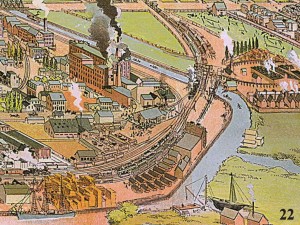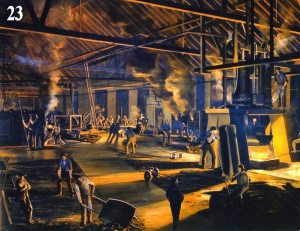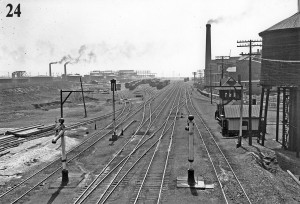Railway Heritage Footprints in the West Donlands – Part 4 of 6
Click on each image for a closer look!
To the east of the passenger station was the freight house. There  are no known photographs of any of the GTR facilities at this location but IMAGE #22 is a segment from an 1896 bird’s eye view of Toronto. The GTR Don Station is the structure at the centre with a blue-coloured pitch roof and was literally surrounded by the Davies pork facilities. One can imagine that boarding a train at GTR’s Don Station was both a raucous and odiferous experience. The station was demolished circa 1907, although the area continued to be known as Don Station into the 1920’s. Canadian National would use Don as a freight yard for the remainder of the 20th century until it was recently purchased by GO Transit.
are no known photographs of any of the GTR facilities at this location but IMAGE #22 is a segment from an 1896 bird’s eye view of Toronto. The GTR Don Station is the structure at the centre with a blue-coloured pitch roof and was literally surrounded by the Davies pork facilities. One can imagine that boarding a train at GTR’s Don Station was both a raucous and odiferous experience. The station was demolished circa 1907, although the area continued to be known as Don Station into the 1920’s. Canadian National would use Don as a freight yard for the remainder of the 20th century until it was recently purchased by GO Transit.
A nother historic railway facility seen on the 1857 map on the east side of East Street was the Toronto Rolling Mills. The interior of this facility is seen in IMAGE #23, a lurid 1864 painting by William Armstrong. The company was established in 1857 by renowned businessman and engineer Casimir Gzowski to remanufacture worn out iron rails and was the largest industry in Toronto, employing over 300 men. The formidable machine on the right is a steam hammer. The company went out of business in 1873 after stronger and much cheaper steel rails manufactured by the Bessemer process became available.
nother historic railway facility seen on the 1857 map on the east side of East Street was the Toronto Rolling Mills. The interior of this facility is seen in IMAGE #23, a lurid 1864 painting by William Armstrong. The company was established in 1857 by renowned businessman and engineer Casimir Gzowski to remanufacture worn out iron rails and was the largest industry in Toronto, employing over 300 men. The formidable machine on the right is a steam hammer. The company went out of business in 1873 after stronger and much cheaper steel rails manufactured by the Bessemer process became available.
Still referring to the 1857 map, the one-block long Kingsford Street seen inside the curve of the Don River was named after Grand Trunk Railway superintendent William Kingsford. On August 26, 1856, the Toronto Globe published a lengthy account describing the opening the day before of the Grand Trunk between Toronto and Oshawa. The article concluded with scathing criticisms of the railway’s engineering standards, the quality of the locomotives, and the general competence of the management. Superintendent Kingsford was singled out for his attentions to female passengers and the Globe stated that the railway should “leave railroad superintendence to someone who has not studied female dress and deportment so deeply, but who can run a train on time.” It is not known if the Globe was suggesting that Kingsford was actually comporting himself in drag or simply admiring female embellishments from a distance. So incensed was Kingsford that he challenged Globe editor Gordon Brown (brother of Globe owner and Father of Confederation Gorge Brown) to a duel. Although nothing came of this, the considerable newspaper coverage devoted to this contretemps amused Torontonians for weeks afterwards.
Th e Canadian National Don Yard is seen in City of Toronto Archives in IMAGE #24. This 1926 photograph is looking west and was probably taken from the top of the bridge over the Don River. On the right was the site of the Grand Trunk Don Station and the most prominent chimney indicates the Davies Company. On the left is the Waterfront Grade Separation embankment being built up for the current Union Station Rail Corridor. The two white-coloured water spouts adjacent to the tracks were fed by the wooden tank on the right. The track curving to the north behind the water tank leads to what is now Canadian National’s Bala Subdivision and the GO Transit corridor to Richmond Hill. The Grade Separation required the removal or relocation shortly after the photograph was taken of all the railway facilities seen here. The only remaining structure in 2012 is the Bascule bridge carrying Cherry Street over the Keating Channel outlet of the Don River, seen in the distant skyline on the upper left.
e Canadian National Don Yard is seen in City of Toronto Archives in IMAGE #24. This 1926 photograph is looking west and was probably taken from the top of the bridge over the Don River. On the right was the site of the Grand Trunk Don Station and the most prominent chimney indicates the Davies Company. On the left is the Waterfront Grade Separation embankment being built up for the current Union Station Rail Corridor. The two white-coloured water spouts adjacent to the tracks were fed by the wooden tank on the right. The track curving to the north behind the water tank leads to what is now Canadian National’s Bala Subdivision and the GO Transit corridor to Richmond Hill. The Grade Separation required the removal or relocation shortly after the photograph was taken of all the railway facilities seen here. The only remaining structure in 2012 is the Bascule bridge carrying Cherry Street over the Keating Channel outlet of the Don River, seen in the distant skyline on the upper left.
Click here to see the next posting in this series.
Click here to return to the first posting in this series.
Posting by Derek Boles, TRHA Historian

